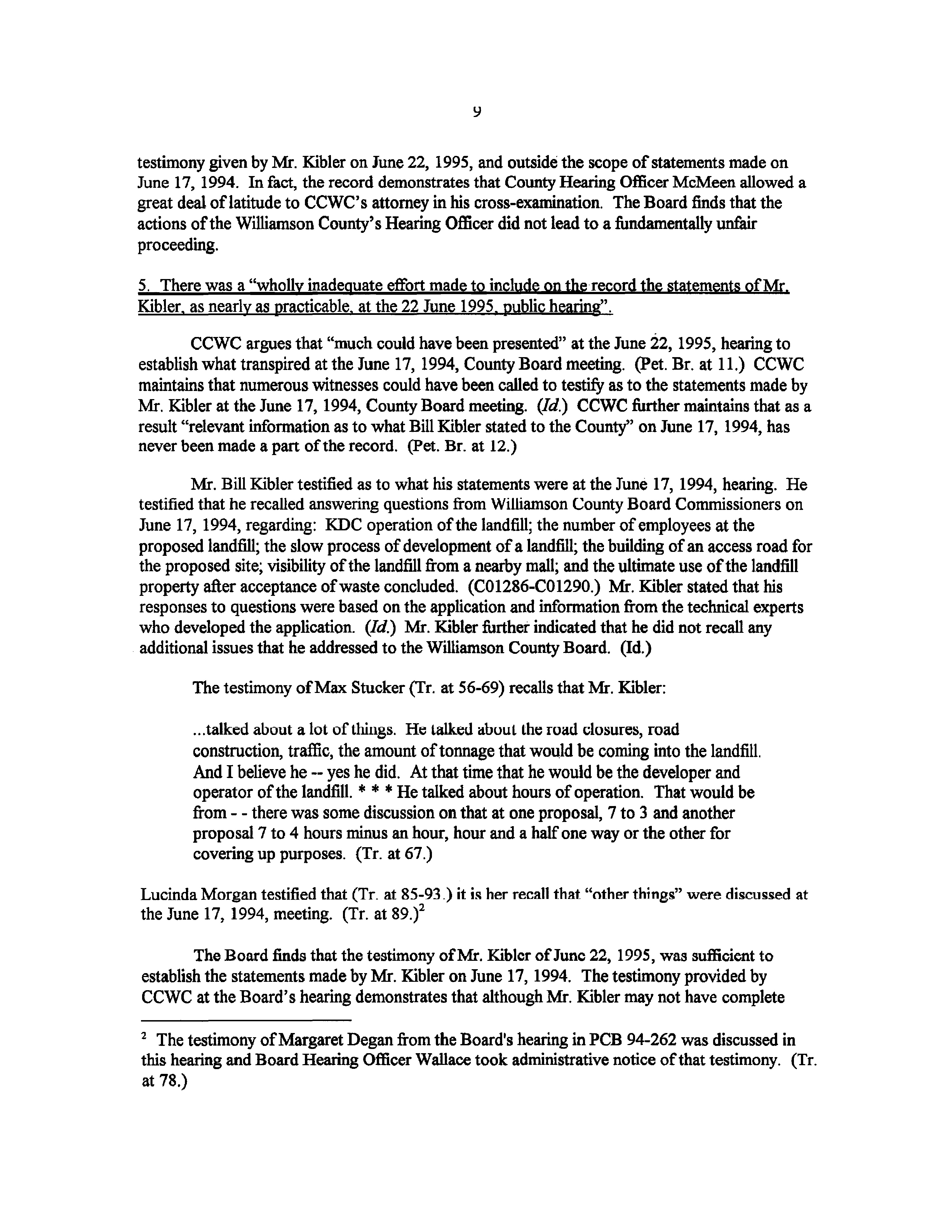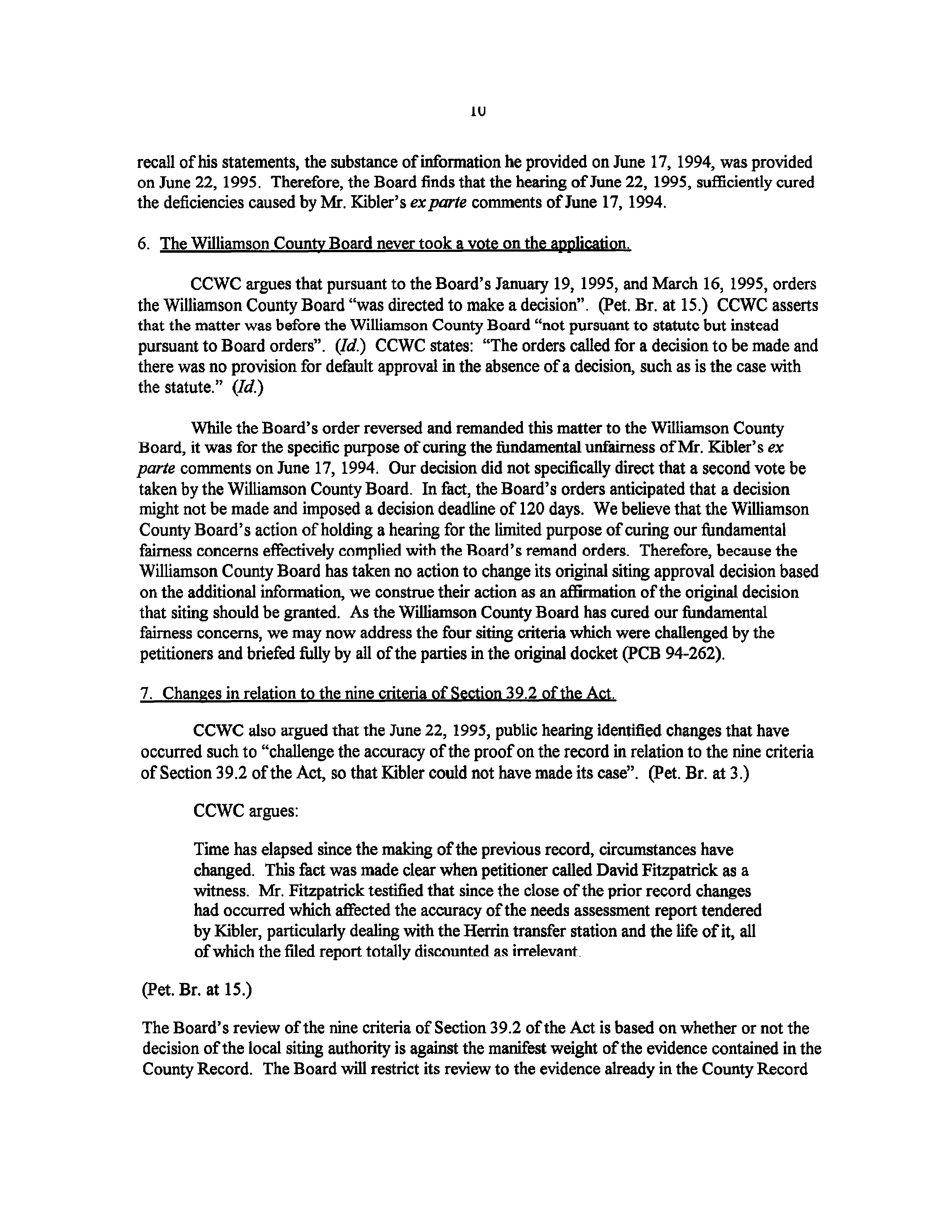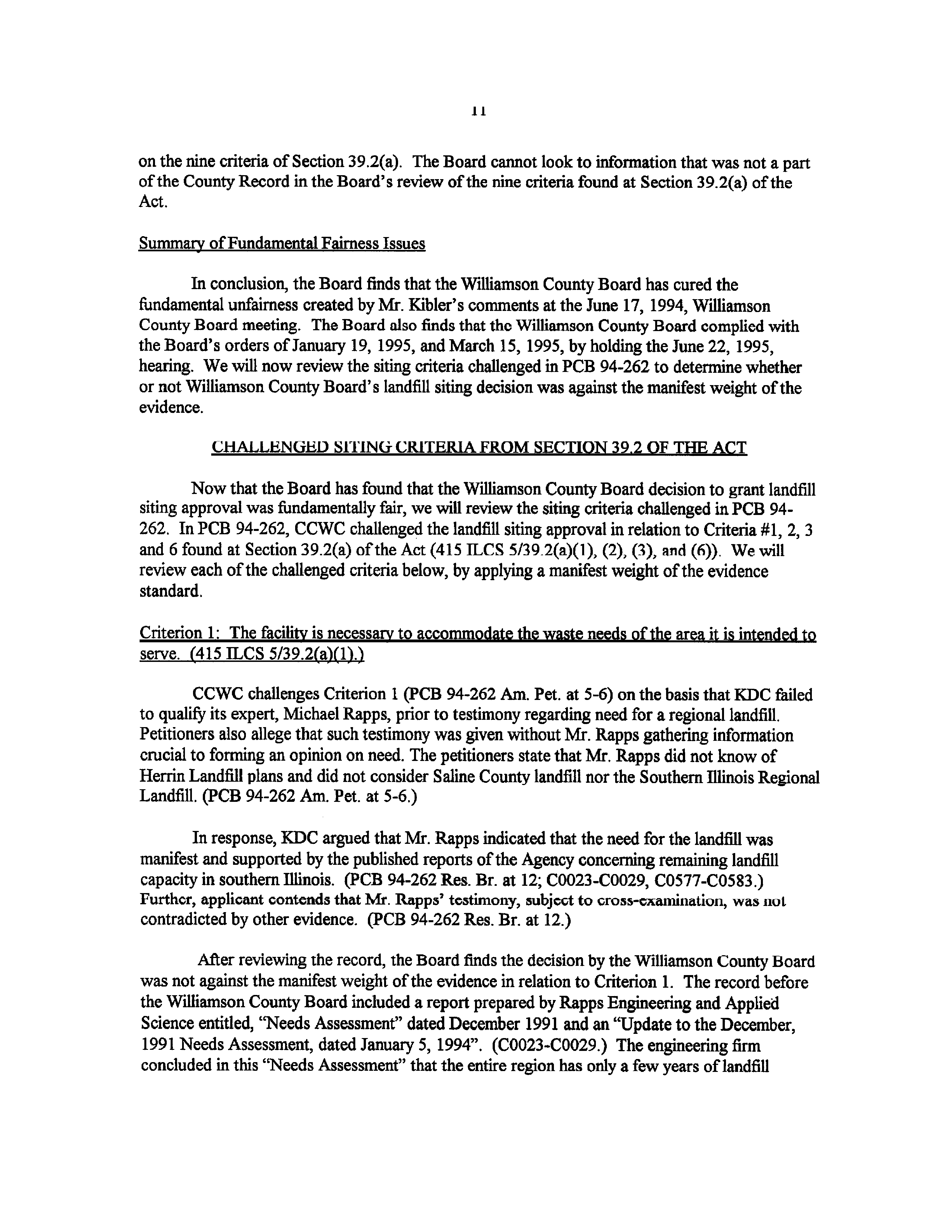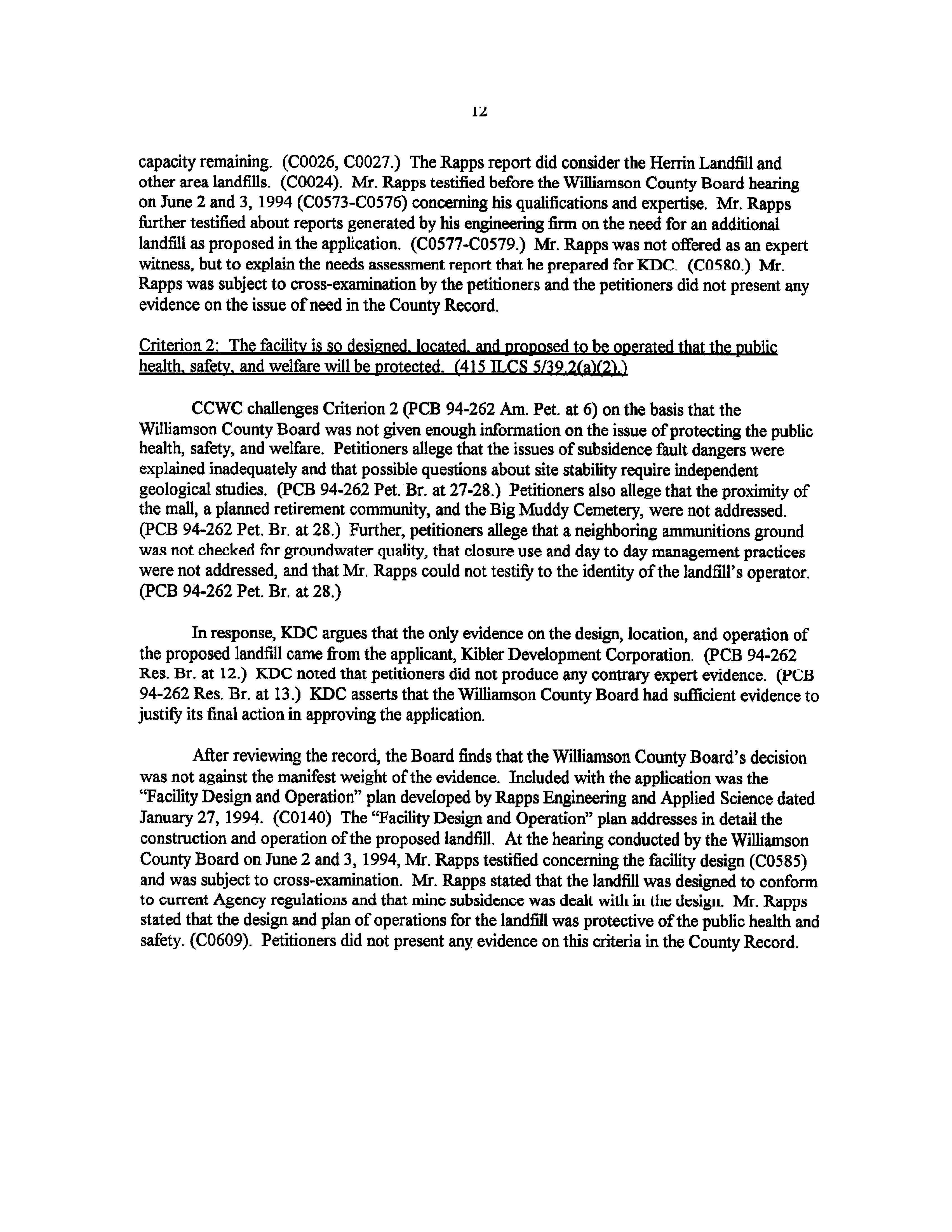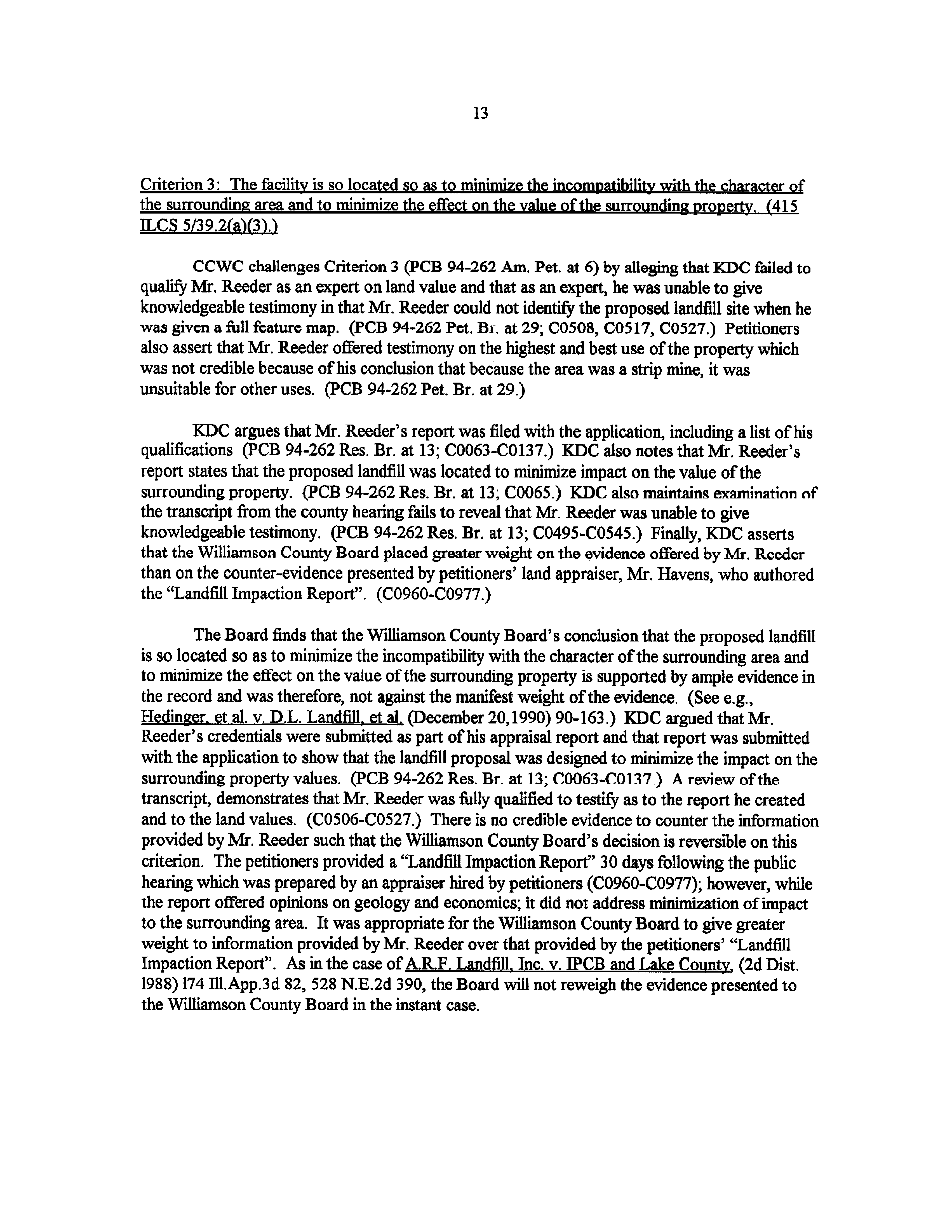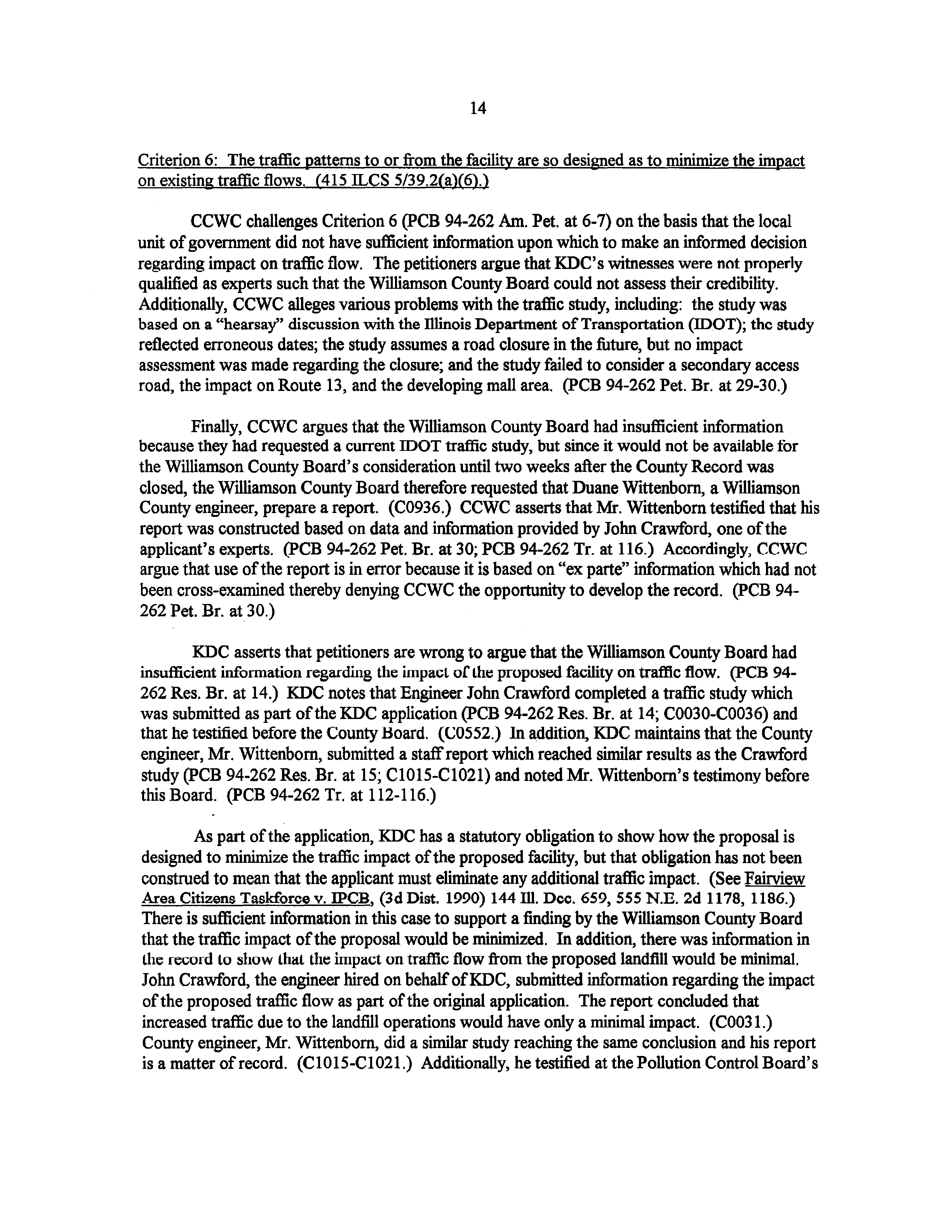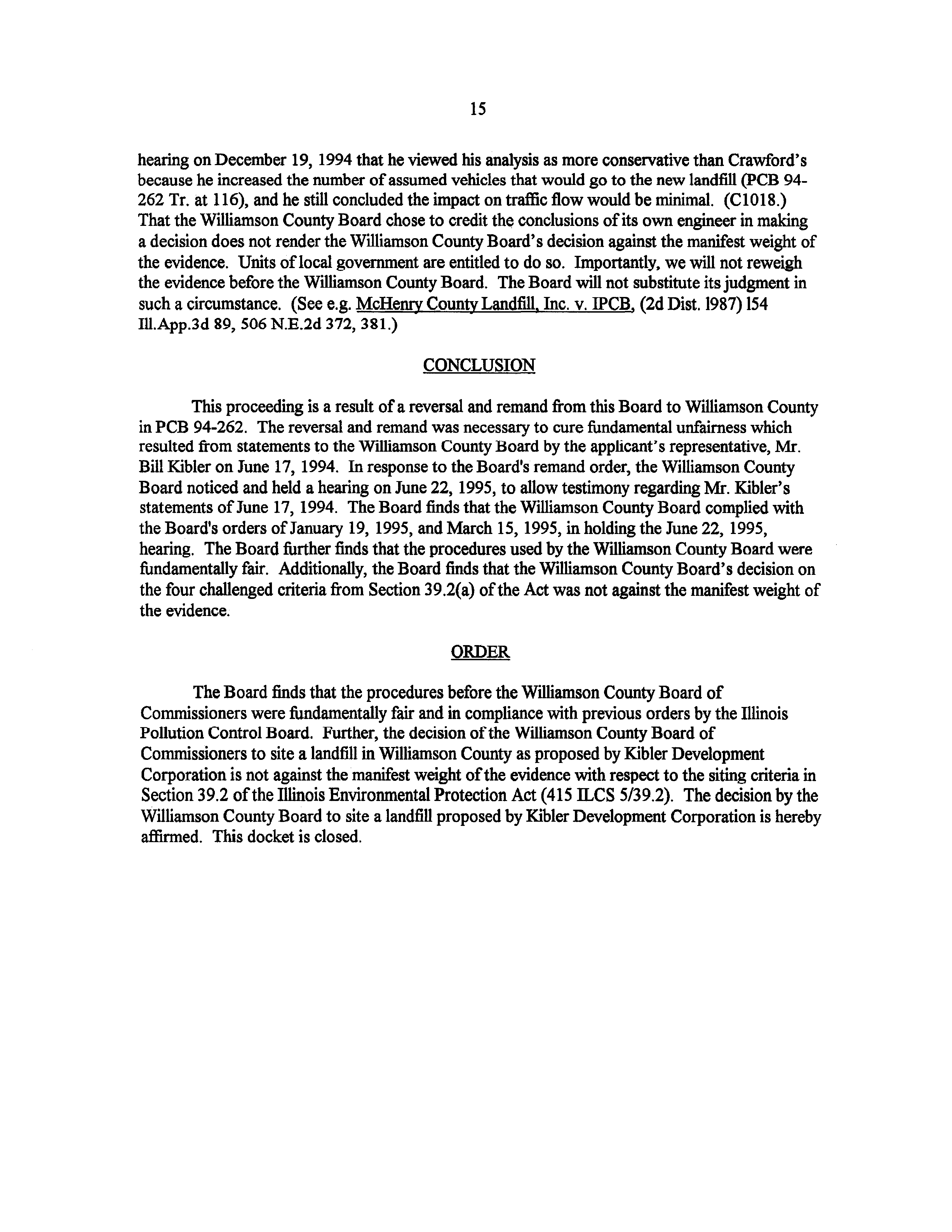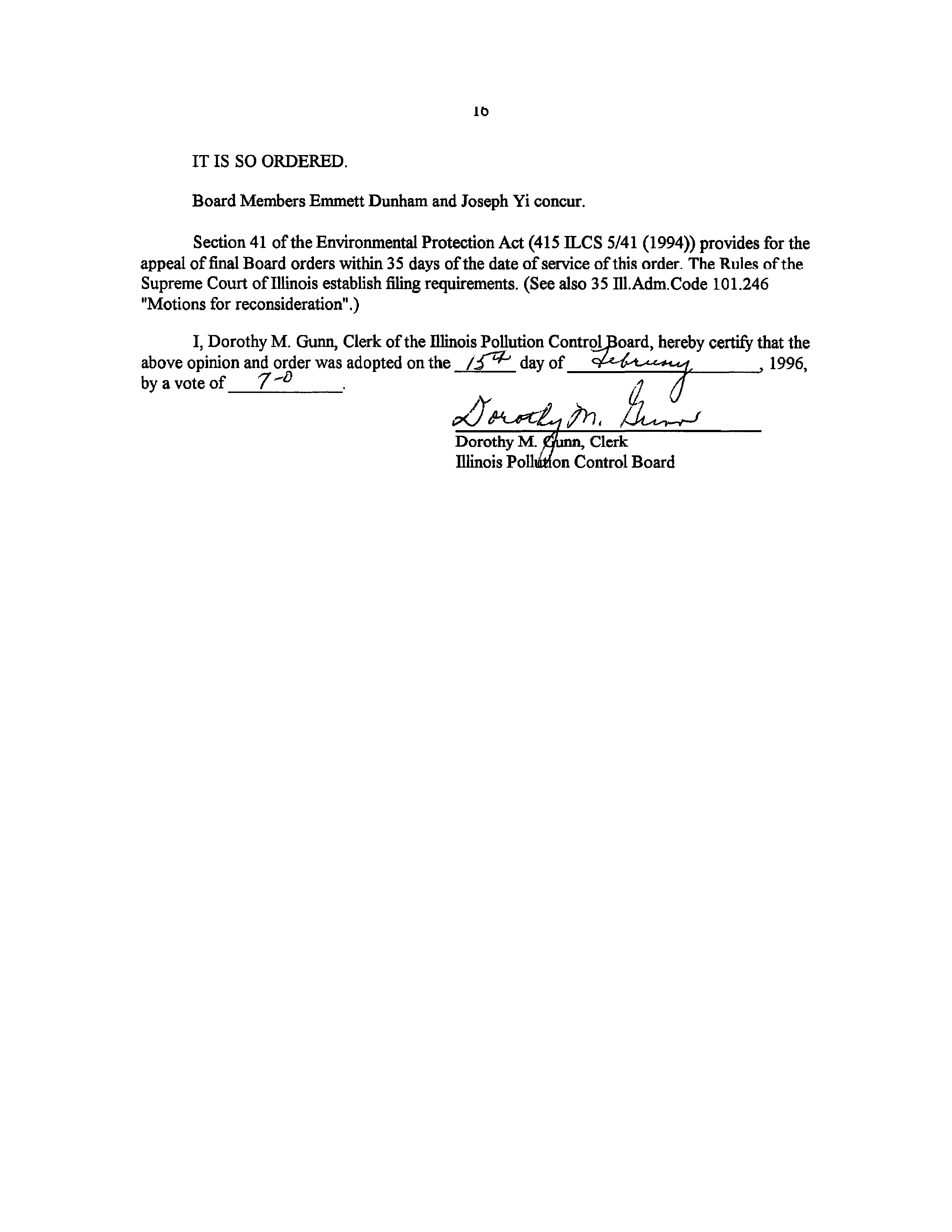ILLINOIS POLLUTION CONTROL BOARD
February
15,
1996
CONCERNED CITIZENS OF WILLIAMSON)
COUNTY ANDREV. PAUL CRAIN AND
)
ROSE ROWELL,
as members ofthe
)
Concerned Citizens ofWilliamson County,
)
)
Petitioners,
)
)
v.
)
P0
96-60
)
(Third Party)
BILLKIBLER DEVELOPMENT CORP.,
)
(Landfill
Siting
Review)
alk/a KIBLER DEVELOPMENT CORP.,
)
AND THE WILLIAMSON COUNTY
)
BOARD OF COMMESSIONERS,
)
)
Respondents.
)
KENNETH A. BLEYER, ESQ., APPEARED ON BEHALF OF THE PETITIONERS;
THOMAS J. IMMEL, ESQ., APPEARED ON BEHALF OF KIBLER DEVELOPMENT
CORPORATION.
OPINION AN)
ORDER OF THE BOARD (by G. T. (Jirard):
This matter is before theBoard on a September
14,
1995,
petition for review, filed by
Concerned Citizens ofWilliamson County, Paul Cram
and Rose Rowell (collectively CCWC).
The Board notes that only respondent Bill Kibler Development Corporation (KDC) filed an
appearance in this proceeding.
Hearing on this matter was heldbefore ChiefBoard Hearing
Officer Michael Wallace on December
13,
1995,
in Marion, Williamson County, Illinois.
Several
members ofthe public were present and made statements on the record in this proceeding.
CCWC’s petition was filed pursuant to Section 40.1 ofthe Illinois Environmental
Protection Act (Act).
(415 ILCS
5/1
et
seq.
(1994).) For the reasons enunciated below, the
Board finds that the proceedings before the Wiffiamson County Board of Commissioners
(Williamson County Board) were ftindamentally fair.
The Board also finds that the decision ofthc
Williamson County Board with respect to the landfill siting criteria at Section 39.2 ofthe Act (415
ILCS 5/39.2) was not against the manifest weight ofthe evidence.
The Board affirms the
Williamson County Board landfill siting decision.
LEGAL FRAMEWORK
Pursuant to Section 3 9(c) and 3 9.2(a) ofthe Act, an applicant for a new pollution
control facility is required to request and receive siting approvalfrom the local
government before a development or construction permit is issued by the Tilinois
Environmental Protection Agency (“Agency”).
(415
ILCS
5/39(c)
and 5/39.2(a).)
Section 39.2(a) provides that local authorities
areto consider nine criteria when reviewing
an application for landfill siting approval.
Only if the local body finds that all applicable
criteria have been met by the applicant can landfill siting be granted.
Section 40.1 ofthe Act (415 ILCS
5/40.1)
authorizes appeal to the Board ofa local
government decision to grant landfill siting approval.
Section 40.1 ofthe Act also requires the
Board to reviewthe proceedings before the local siting authority to assure ftindamental fairness.
In E & E Hauling, Inc. v.
1PCB (2d Dist.
1983),
116 Ill.App.3d 586,
594, 451 N.E.2d
555,
564,
affd inpart (1985),
107 Ill.2d 33, 481 N.E.2d 664, the appellate court found that although
citizens before a local decision-maker arenot entitled to a fair hearing by constitutional
guarantees ofdue process, procedures at the local level must comport with due process standards
offtindamental fairness.
The court held that standards ofadjudicative due process must be
applied.
(See also Industrial Fuels, 227
Il1.App.3d 533,
592 NE~2d
148; Iat~.
188 TilApp
lid
994,
544 N.E.2d 1176.)
Due process requirements aredetermined by balancing theweight ofthe
individual’s interest against society’s interest in effective and efficient governmental operation.
(Waste Management ofIllinois Inc.
v. IPCB (2d Dist.
1989),
175 Ill.App.3d 1023,
530 N.E.2d
682.)
The manner in which the hearing is conducted, the opportunity to be heard, the existence of
ex pane contacts, prejudgment ofadjudicative facts, and the introduction ofevidence are
important, but not
rigid,
elements in assessing fUndamental fairness.
(Fledinger v. D & L Landfill,
Inc,~
(December 20,
1990), PCB
90-163,
117 PCB
117.)
Board review of a local government decision approving landfill siting must apply the
“manifest weight ofthe evidence” standard ofreview (Waste Management ofIllinois, Inc.
v.
IPCB (1987),
160 Ill.App.3d 434,
112 Ill.Dec.
178,
513 N.E.2d
592;
see also City of~
IPCB (1984),
125 fll.App.3d 384,
80 fll.Dec. 650,
465
N.E.2d 996).
A decision is against the
manifest weight ofthe evidence if the oppositeresult is clearly evident,
plain, or indisputable from
a review ofthe evidence.
(Harris v.
Day,
115 Ill.App.3d 762,
451
N.E.2d 262.)
The province of
the hearingbody is to weigh the evidence, resolve conflicts in testimony, and assess the credibility
ofthe witnesses.
Merelybecause we could reach a different conclusion, is not sufficient to
warrant rcvcraal.
(City ofRockford v. IPC3
and Frink’s Industrial Waste, (2d Dist.
1984)125
Il1.App.3d 384,
465 N.E.2d996; Waste Management ofIllinois. Inc.
v. IPCB, (3dDist.
1984) 22
Il1.App.3d 639,
461 N.E.2d 542; Steinberg v. Petta.
(1st Dist. 1985)139 Ill.App.3d 503, 487
N.E.2d1064; Wlllowbrook Motel v.
IPCB.
(1st Dist. 1985) 135 fll.App.3d 343,
481 N.E.2d 1032.)
3
BACKGROUND
This petition forreview
arose from a previous case before theBoard in which the Board
remanded the proceeding to Williamson County.
(Concerned Citizens ofWilliamson County
et
al.
v.
Bill Kibler Development and Williamson County Board of
Commissioners
et a!
PC~B
94..
262 (hereinafterPCB 94-262).)
InPCB 94-262, the Board found in an opinion and order dated
January
19,
1995, that the
exparte
comments by Mr.
Bill
Kibler concerning technical aspects of
the application at a meeting ofthe Williamson County Board on June 17,
1994 had ledto a
fundamentally unfair proceeding.
(PCB 94-262
1/19/95 at 8.)’
In addition to allowing Mr.
Kibler to address the technical merits ofthe application at that June 17,
1994, meeting, the
Williamson County Board had established that public comments would not be allowed atthe
meeting and audience members would be excluded if the audience attempted to participate in the
discussion.
(Id.)
The Board stated:
Clearly, the June 17 meeting was an
exparte
discussion albeit one that is
summarized in the public record.
(C0936.)
The existence
ofexparte
contacts is
an element in assessing fundamental fairness.
(Hedinger v. D & L Landfill, Inc.,
(December 20,
1990), PCB
90-163,
117 PCB
117.)
The Board does not take
issue with the County Board’s intended purpose at the
special meeting
of
June 17,
1994:
a publicly viewed discussion with the County Board’s experts on the
technical aspects ofthe application.
However, the participation ofonly one party
(Bill Kibler, owner of
Kibler
Development), in thediscussion, does not comport
with the adjudicatorystandard, including the exclusion
ofexparte
contacts.
(PCIB
94-262 1/19/95 at
9.)
InPCB 94-262, theBoard did not reach the reviewofthe nine criteriafound at Section
39.2 ofthe Act, because ofthefinding offlmdamental unfairness.
CCWC’s petition (PCB 94-262
Am. Pet. at 1-7) had challenged the Williamson County Board’s siting approval decision in
relation to several ofthe siting criteria at Section 39.2 oftheAct.
The Board determined that remand was the proper course ofaction for this proceeding
and remanded the caseto the Williamson County Board.
Q?CB 94-262 1/19/95
at 14.)
OnMarch
16,
1995, in response to a motion to
clarify theBoard stated in its order:
The orders from PCB 94-262 will be cited by date and page number; the petitioner’s briefin
PCB 94-262 will be citcd as “PCB 94-262 Pet. Br. at
_“;
the respondent’s briefin PCB 94-262
will be cited as “PCB 94-262 Res. Br.
at
_“;
the first amended petition in PCB 94-262 will be
cited as “PCB
94-262 Am. Pet. at
_“;
the Board hearing transcript in PCB 94-262 will be cited
as “PCB
94-262 Tr. at
“;
the petitioners’ briefin the instant case will be cited as “Pet. Br. at
_“;
the respondent’s briefin the instant case
will
be cited as “Res. Br. at
_“;
the record before
the Williamson County Board will be cited as “C
“;
and the transcript from theBoard’s
December
13,
1995,
hearing will be cited as “Tr.
at
“.
4
The August 23,
1994, decision ofthe Williamson
County Board of
Commissionersgranting siting approval to Kibler Development Corporation, is
hereby reversed and remanded as a result ofa fundamentally unfair proceeding.
Upon remand ofthis proceeding:
1.
Williamson County shall provide notice ofpublic hearing, and hold
it
in
accordance with the provisions of Section 39.2 ofthe Act, including a
presentation, as nearly as practicable, ofthe statements made by Mr. Bill
Kibler
at
the June 17,
1994,
special meeting, as well as oppurtunity fur
questions concerning orrebuttal to, Mr. Kibler’s statement.
Mr. Bill Kibler
shall attend the public meeting and be available to address potential
questions concerning his statements ofJune 17,
1994.
2.
Williamson County shall provide for a post-hearing comment period as
provided in Section 39.2 ofthe Act.
3.
Williamson County’s siting decision must be based on the entire record
before it including the public hearingheld pursuant to this order, in
accordancewith Section 39.2 ofthe Act.
4.
Williamson County’s siting decision shall be consistent with this order and
theBoard’s January
19,
1995, opinion in this proceeding.
5.
The 120
day statutory decision time begins
35 days afterthe date ofthis
order.
This docket is closed.
(PCB 94-262
3/16/95
at 2.)
On
May
31,
1995, theFifth District Appellate Court dismissed an appeal by both CCWC
and KDC ofthe Board’sJanuary
19,
1995, opinion and order.
(Concerned Citizens of
Williamson County, et al.
and Kibler Development Corporation v.
Illinois Pollution
Control Board
and Williamson County Board ofConiniissione~~,
No.
5-95-0250,111. App. 5th District, May 31,
1995.)
The appeal was dismissed for lack ofjurisdiction on theBoard’s motion becausethe
orders in question were not final.
On remand, the Williamson County Board ofCommissioners noticed a public hearing in
the
Southernliinoisan
on June 2,
1995.
(C01208-C0121 1,
CO 1242.)
The notice indicated, in
part, that the public hearing had been ordered by theBoard to “present, as nearly as practicable,
the statements ofMr. Bill Kibler at theJune
17, 1994” special meeting ofthe Williamson
County
Board.
(Id.)
On June22,
1995, the Williamson County hearingwas held and statements were
taken from Mr. Bill Kibler and others.
On August 17,
1995, the Williamson County Board of
Commissioners met to discuss the landfill siting and did not vote on the application.
(COl4lS-
C0l419.)
The County’s Record from PCB 94-262 was incorporated into the County’s Record in
theinstant case by Williamson County Hearing Officer McMeen.
(CO 1282.)
The Board at this
time incorporates the transcript, briefs and opinions and orders from PCB 94-262 into this docket
by reference.
PRELIMINARY MATTERS
Waiver ofarguments
CCWC stated in its final briefthat CCWC waives any argument on certain issues.
(Pet.
Br.
at
15-16.)
CCWC waived argument regarding Mr. Bill Kiblcr’s credibility (Pet. Br.
at 14-15)
as well as argument on the timeliness ofthe inaction by the Williamson County Board.
(Pet. Br.
at 16.)
Therefore, theBoard will not further discuss those issues in this opinion.
HearingNotice for June 22.
1995
hearing
CCWC argues that the Board’s orders in PCB 94-262 were not complied with in that the
public notice ofthepublic hearing held pursuant to those orders did not “advise the public ofthe
purpose ofthe meeting on 22 June 1995”.
(Pet. Br. at 3.)
CCWC points out that the notice of
hearingindicated that thepurpose for thehearing scheduled June 22,
1995, was to take
“testimony from Bill Kibler”.
(Pet. Br. at 13.)
CCWC argues that this “is not what thepurpose
of
the
public hearing was according
to the orders of the Board”.
(Id.)
CCWC maintains that the
purpose ofthe hearingon remandwas “that a ‘new’ 39.2
public hearing be held which, in part,
was to include a recreation, as nearly as practicable, ofthestatements made by Bill Kibler on
17
June 1994”.
(Pet Br. at
13-14.)
After careful review ofthe notice (CO 1208-CO1211) and the arguments, theBoard finds
that the notice ofthe June 22,
1995,
hearing was sufficient.
(See
Infra
p.7.)
HearingNotice for Board’s December
13.
1995
hearing
CCWC asserts that improper notice was given for theBoard’s hearingbecause the
published notice appeared in the
Marion Dai~v
Republican.
(Pet. Br.
at 21-22.)
CCWC argues
that although the
Marion DailyRepublican
is published in Williamson County it is not generally
circulated in the county and thus notice oftheBoard’s hearing was invalid.
(Pet. Br. at 22.)
Section 40.1 ofthe Act states:
“TheBoard shall publish 21
day notice ofthe hearing on
the appeal in a newspaper ofgeneral circulation published in that county”.
(415 ILCS
5/40.1(a).)
CCWC concedesthat the
Marion
Daily
Republican
is published
in
Williamson County.
The
Marion DailyRepublican
is circulated within Williamson County; therefore, thejurisdictional
requirements have been met.
(Village ofLaGrange
et a!.
v. McCook Cogeneration Station
et a!.,
PCB 96-41 (December
7,
1995).)
Board Hearing Officer rulings
CCWC seeks review ofrulings by the Board’s hearing officerin three areas.
First, CCWC
asserts that the hearing officer erred in denying petitioner’s emergency motion to reconvene the
6
discovery deposition ofBill Kibler.
(Pet. Br. at 4.)
Second, CCWC argues that the hearing
officer erred in quashing the subpoena ofMike
Post.
(Id.)
Third,
CCWC maintains that the
hearing officer erred in “refusing to allow petitioners theopportunity to elicit testimony from Bill
Kibler and other witnesses during the petition for review hearing”.
(Id.)
With reference to thefirst two alleged errors theBoard affirmsthe hearing officer’s
rulings.
A careful review ofthe arguments as well as the transcripts from the Board’s hearing and
the deposition, indicates therulings madeby thehearing officer were correct based on rules of
evidence and the Board’s own
procedural rules.
With referenceto the third alleged error, the
Board finds that the hearing officer did err in sustaining objections to thetestimony ofMax
Stucker and Lucinda Morgan.
The testimony ofthese witnesses dealt with the issue of
fundamentalfairness and wastherefore admissible.
Therefore, the offers ofproofwill be accepted
as testimony from Max Stucker and Lucinda Morgan and considered in renderingthe Board’s
decisionin this case.
ARGUMENTS
CCWC argues that the Board’s orderswere not complied within six areas.
Those six
areas are:
1.
The Williamson County Board failed to conduct a “new hearing” on June 22,
1995.
(Pet Br.
at 3.)
2.
KDC failed to makea case for its application for siting approval at the June 22,
1995, hearing.
(Id.)
3.
The Williamson County Board hearing officer improperlytook “administrative
notice” ofthe record, allowed reference to it by KDC and advised the Williamson
County Board to
entertainthe same in its deliberations without proper foundation
orjustification.
(Id.)
4
Petitioners were denied an opportunity to question Bill Kibler on June 22,
1995,
as
to all matters germane to the comments he had made on June 17,
1994.
(Id.)
5.
There was a “wholly inadequate effort made to include on the recordthe
statements ofMr. Kibler, as nearlyas practicable, atthe 22 June
1995, public
hearing”.
(Id.)
6.
The Williamson
County Board never took a vote on theapplication.
(Pet. Br.
at
3-4.)
In addition,
a seventh issue was raised when CCWC argued that the June 22,
1995,
public hearing
identified changes that have occurred such to “challenge the accuracy ofthe proofon the record
in relation to the nine criteria ofSection 39.2 ofthe Act, so that Kibler could not have made its
case”.
(Pet. Br. at 3.)
Eachofthe seven issues in this appeal will be discussed below.
/
1.
Williamson
County failed to conduct a “new
hearing” on June 22.
1995.
CCWC argues that the Williamson County Board failed to hold a “new public hearing”
contraryto the Board’s orders of January 19,
1995,
and March 16,
1995.
CCWC maintains that
the orders ofthe Board direct that a new public hearingbe held pursuant to Section 39.2 ofthe
Act; but do not establish “any limitations on the application of Section
392”
ofthe Act.
(Pet. Br.
at
5.)
CCWC asserts that a “cursory reading ofthe transcript” from June 22,
1995,
public hearing
establishes that Section 39.2 ofthe Act was not followed.
(Id.)
KDC maintains that the Board’sMarch 16,
1995, order “required” the Williamson County
Board to consider “everything that occurred regarding thepending KDC application 2ri~jto the
remand aswell as the June 22nd public hearing itself’.
(Res. Br. at 6.)
Thus, KDC appears to be
arguing that this is not a new proceeding but a continuation ofthe prior proceeding.
The Board agrees that this is a continuation ofthe prior proceeding.
The Board’s orders
ofJanuary
19,
1995,
and March
16,
1995, remanded this proceeding to cure an error which had
led to a fundamentally unfair proceeding.
Although the Board’s order closed theprevious docket,
theBoard did not require that the applicant provide notice ofa newpetition or a new petition be
filed.
Further, theBoard did not simply reverse the Williamson County Board but, instead, the
Board reversed and remanded this matter.
Clearly, theBoard did not intend that the application
process must begin anew.
The Board’s order ofMarch
16,
1995, clearly requiredthat a hearing
would be held and at that hearingMr. Kibler would testi& asto his statementsofJune
17,
1994.
The Board’s orders directed that a “new” hearing be held because the previous public hearing had
been held and the record closed.
The record indicates
that the Williamson County Board’s hearing officer (Patricia
McMeen) had a clear understanding ofthe Board’s orders on this issue.
Hearing Officer McMeen
stated:
It is my understanding ofthe PCB’s ordersthat the fundamentalfairness issue was
based upon the meeting ofJune
17,
1994.
That is why the decision was reversed
and the matter was remanded, that issue alone, and the basis is themeeting that
was held; therefore, I view this as a supplementalproceeding to correct that lack
of
fundamentalfairness.
(CO1259-C01260.)
Thus, the Boardfinds that Williamson County properly opened anew hearing, but
also included
the record from the prior proceeding.
2.
KDC
failed to
make acase for its analication for siting approval at the June 22, 1995.
hearing.
3.
The Williamson County Board hearinR officer imnroperlv took “administrative notice”
olfthe
record, allowed reference to
it by KDC and advisedthe Williamson County Board to entertain the
same in its deliberations without proper foundation or justification.
CCWC maintains that no record for the siting application was made because “absent
KDC’s request for administrative notice ofthe record oftheprior proceeding nothing was done
8
to make a case for siting”.
(Pet. Br. at 6.) CCWC then argues that itwas error for the
Williamson County hearing officerto takeadministrative notice ofthe “prior record” as no
foundationwas laid.
CCWC statesthat “time has elapsed sincethe making ofthat record” and
“circumstances have changed”.
(Pet. Br. at 14.)
KDC argues that this is
a continuation ofthe previous proceeding.
~Res.Br. at 6.)
Inall1
event, KDC
asserts that
it incorporated the entire record into its presentation ofJune 22,
1995,
and “handed the entirety over” to the Williamson County Board for decision.
(Id.)
The Board finds that County Hearing Officer McMeen appropriatelyincorporated the
County Record from PCB 94-262 into this proceeding.
As discussed above, the remand to the
Williamson County Board was in order to cure deficiencies in therecord from
expcrrte
comments,
not to beginthe application process anew.
Therefore, the Board finds that the record is sufficient
to
support the landfill siting decision ofthe Williamson County Board.
4.
Petitioners were denied an opportunity to question Bill Kibler on June 22,
1995.
as to all
matters germane to the comments he had made on June 17.
1994.
CCWC states:
With this petition forreview the petitioner would show that had they been allowed
to asklegitimate questions within the scope ofwhat theBoard authorized upon
remand enlightening and provocative informationwould have surfaced which the
County should have known in making its determination on whether or not to site.
It was barring ofthe questions which made the proceedingsfundamentally unfair.
(Pet. Br. at
7.)
KDC maintains that County Hearing Officer McMeen wascorrect in precluding the cross-
examination ofMr. Bill Kibler “for four different reasons”.
(Res. Br. at 7.)
KDC first argues that
certain ofthe questions posed by CCWC related to issues which were “not even mentioned” on
June 17,
1994.
(Id)
Second, KDC
asserts that
with regard to those same issues, Mr. Kibler did
not discuss those issues in direct testimony.
(Id)
Third, KDC argues that the applicable statutory
criteriado not include the financial state ofthe applicant among them.
(Id)
And finally, KDC
asserts that based on Southwest Energy Corp.
v. PCB
(4th Dist.
Sept.
7,
1995)
No. 4-94-0759,
petitioners do not have the rightto cross-examine witnesses at siting hearings.
(Id)
County HearingOfficer McMccn
sustained
objections by KDC’s attorney at CO 1297,
CO1309 and C013 11
ofthe County Record.
The first objection was that the question posed had
been asked and answered.
The second objection sustained was to the question “What are the
assets ofthe corporation?”.
(C01306-C01307.)
The last objection sustained was to the question
“How is your corporation affiliated with Fred Barbara (ph)?”
(CO 1310.)
Hearing Officer
McMeen madeher rulings on the record after hearing arguments by CCWC’s attorney, KDC’s
attorney and the county’s attorney.
The Board can find no argument on therecord or in the briefs
which convinces theBoard that County HearingOfficer McMeen ruled incorrectly.
County
HearingOfficer McMeen sustained objections to questions which were outaide the scope ofthe
9
testimony given by Mr.
Kibler on June 22,
1995,
and outside the scope ofstatements madeon
June 17,
1994.
Infact, therecord demonstrates that County Hearing Officer McMeen allowed a
great deal oflatitude to CCWC’s attorney in his cross-examination.
The Board finds that the
actions ofthe Williamson County’s Hearing Officer did not lead to a fundamentally unfair
proceeding.
5.
There was a “wholly inadequate effort made to include oniherecord the statements ofMr.
Kibler. as nearly as practicable. at the 22
June
1995,
public hearing”.
CCWC argues that “much could have been presented” at the June 22,
1995, bearingto
establish what transpired atthe June 17,
1994,
County Board meeting.
(Pet. Br. at 11.)
CCWC
maintains that numerous witnesses could have been called to testify asto the statements made by
Mr. Kibler at the June
17,
1994,
County Board meeting.
(Id.)
CCWC further maintains that
as a
result “relevant information as to what Bill Kibler stated to the County” on June 17,
1994, has
never been made a part oftherecord.
(Pet. Br. at 12.)
Mr. Bill K.ibler testified as to what his statements were atthe June
17,
1994,
hearing.
He
testified that he recalled answering questions from Williamson County Board Commissioners on
June 17,
1994, regarding:
KDC operation ofthe landfill; the number ofemployees at the
proposed landfill; the slow process ofdevelopment ofa landfill; thebuilding ofan access road for
the proposed site; visibility ofthe landfill from a nearbymall; and the ultimate use ofthe landfill
property after acceptance ofwaste concluded.
(C01286-C01290.)
Mr. Kibler stated that his
responses to questions were based on the application and informationfrom the technical experts
who developed theapplication.
(Id.)
Mr. Kibler further indicated that he did not recall any
additional issuesthat he addressed to the Williamson County Board.
(Id.)
The testimony ofMax Stucker (Tr.
at 56-69) recalls that Mr. Kibler:
...talked about a lot ofthings.
He talked about the road closures, road
construction, traffic, the amount oftonnage that would be coming into the landfill.
And I believe he
--
yes he did.
At
that time that he would
be thedeveloper and
operator ofthe landfill.
*
*
*
He talked abouthours ofoperation.
That would be
from
-
-
therewas some discussion on that at one proposal,
7 to
3 and another
proposal 7 to 4 hours minus an hour, hour and a halfone way or the other for
covering up purposes.
(Tr.
at67.)
Lucinda Morgan testified that
(Tr. at 85-93) it
is
her
recall that “other things” were discussed at
the June
17,
1994, meeting.
(Tr.
at
89.)2
The Board finds
that the testimony of Mr. Kibler
ofJune 22,
1995, was sufficient to
establish the statements madeby Mr. Kibler on June 17,
1994.
The testimony provided by
CCWC at theBoard’s hearing demonstrates that although Mr. Kibler may not have
complete
2
The testimonyofMargaretDegan from theBoards hearing in PCB 94-262 was discussed in
this hearing and Board HearingOfficer Wallace took administrative notice ofthat testimony.
(Tr.
at 78.)
‘U
recall ofhis statements, the substance ofinformation he provided on June 17,
1994, was provided
on June 22,
1995.
Therefore, the Board finds that
the hearing ofJune 22,
1995, sufficiently cured
the deficiencies caused by Mr. Kibler’s
exparte
comments ofJune
17,
1994.
6.
The Williamson County Board never took a vote on the application.
CCWC argues that pursuant to the Board’s January
19,
1995,
and March
16,
1995, orders
the Williamson County Board “was directed to make a decision”.
(Pet. Br. at
15.)
CCWC asserts
that thematter was before the Williamson County Board “not pursuant to statute but instead
pursuant to Board orders”.
(Id.)
CCWC states:
“The orders called for a decision to be madeand
there was no provision for default approval in the absence ofa decision, such as is the casewith
the statute.”
(Id.)
While theBoard’s order reversed and remanded this matter to the Williamson
County
Board, itwas for the specific purpose ofcuring the thndamental unfairness ofMr. Kibler’s
ex
pane
comments on June
17,
1994.
Our decision did not specifically direct that a second vote be
takenby the Williamson
County Board.
In fact, theBoard’s orders anticipated that a decision
might not be made and imposed a decision deadline of 120 days.
We believe that the Williamson
County Board’s action ofholding a hearing for the limited purpose ofcuring our fundamental
fairness concerns effectively complied with the Roard’s remand orders.
Therefore, because the
Williamson County Board has taken no action to change its original siting approval decisionbased
on the additional information, we construe their action as an affirmation ofthe original decision
that siting should be granted.
As the Williamson County Board has cured our fundamental
fairness concerns, we may now address the four siting criteria which were challenged by the
petitioners and briefed fully by
all ofthe parties in the original docket (PCB 94-262).
7.
Changes in relation to the nine criteria ofSection 39.2
ofthe Act.
CCWC also argued
that the June 22,
1995,
public hearing identified changes that have
occurred such to “challenge the accuracy ofthe proofon the record in relation to the nine criteria
ofSection 39.2 oftheAct,
so that Kibler could not have made its case”.
(Pet. Br. at 3.)
CCWC argues:
Time has elapsed since the making ofthe previous record, circumstances have
changed.
This fact was made clear when petitioner called David Fitzpatrick as a
witness.
Mr. Fitzpatrick testified that since the close ofthe prior record changes
had occurred which affected the accuracy ofthe needs assessment report tendered
by Kibler, particularly dealing with the Herrmn transfer station and the life ofit, all
ofwhich thefiled report totally discounted as irrelevant.
(Pet. Br.
at
15.)
The Board’s review ofthe nine criteria of Section 39.2 ofthe Act is based on whether or not the
decision ofthe local siting authority is againstthe manifest weight ofthe evidence contained in the
County Record.
The Board will restrict its reviewto the evidence already in the County Record
I’
on the nine criteria ofSection 3 9.2(a).
The Board cannot look to information that wasnot a part
ofthe County Record in theBoard’s review ofthe nine criteria found at Section 39.2(a) ofthe
Act.
Summary ofFundamental FairnessIssues
In conclusion, the Board finds that the Williamson
County Board has cured the
ftindamental unfairness created by Mr. Kibler’s comments at the June 17,
1994, Williamson
County Board meeting.
The Board also finds that thc Williamson County Board complied with
the Board’s orders ofJanuary
19,
1995,
and March 15,
1995, by holding theJune 22,
1995,
hearing.
We will now review the siting criteria challenged in PCB 94-262 to determine whether
or not Williamson County Board’s landfill siting decision was against themanifest weight ofthe
evidence.
CI-IALLENUBI.) SITINU CRITERIAFROM
SECTION 39.2 OF THE ACT
Now that theBoard has found that the Williamson County Board decision to grant landfill
siting approvalwas fundamentally fair, wewill review the siting criteria challenged in PCB 94-
262.
In PCB
94-262, CCWC challenged the landfill siting approval in relation to Criteria #1,
2,
3
and
6 found at Section 39.2(a) ofthe Act (415 ILCS 5/392(a)(1),
(2), (3), and (ñ)).
We will
review each ofthe challenged criteria below, by applying a manifest weight ofthe evidence
standard.
Criterion
1:
The facility is necessary to accommodate the waste needs ofthe area it is intended to
serve.
(415 ILCS
5/39.2(a)(1).)
CCWC challenges Criterion I (PCB 94-262 Am. Pet. at
5-6)
on the basis that KDC failed
to quality its expert, Michael Rapps, prior to testimony regarding need for a regional landfill.
Petitioners also allege that suchtestimony was given without Mr. Rapps gathering information
crucial to forming an opinion on need. The petitioners state that Mr. Rapps did not how of
Herrin Landifil plans and did not consider Saline County landfill northe Southern Illinois Regional
Landfill. (PCB 94-262 Am. Pet. at
5-6.)
In response, KDC argued that Mr. Rapps indicated that theneed for the landfill was
manifest and supported by the published reports oftheAgency concerning remaining landfill
capacity in southern illinois.
(PCB 94-262 Res. Br.
at 12; C0023-C0029, C0577-C0583.)
Further, applicant contends that Mr. Rapps’ testimony, subjectto cross-examination, was not
contradicted by other evidence.
(PCB 94-262 Res. Br. at 12.)
After reviewing the record, the Board finds the decision by the Williamson County Board
was not against the manifest weight ofthe evidence in relation to Criterion
1.
The record before
the Williamson County Board included a report prepared by Rapps Engineering and Applied
Science entitled, “Needs Assessment” dated December 1991 and an “Update to theDecember,
1991 Needs Assessment, dated January
5,
1994”.
(C0023-C0029.)
The engineering firm
concluded in this “Needs Assessment” that the entire region has only a fewyears oflandfill
12
capacity remalning.
(C0026, C0027.)
The Rapps report did consider the Herrin Landfill and
other area landfills.
(C0024).
Mr. Rapps testified before the Williamson County Board hearing
on June 2 and 3,
1994 (C0573-C0576) concerning his qualifications and expertise.
Mr. Rapps
further testified about reports generated by his engineering firm on the needfor an additional
landfill as proposed in the application.
(C0577-C0579.) Mr. Rapps was not offered as an expert
witness, but to explain the needs assessment report that he prepared for
KDC.
(C05R0.)
Mr.
Rapps was subject to cross-examination by thepetitioners and the petitioners did not present any
evidenceon the issue ofneed in the County Record.
Criterion 2:
The faciliw is so
designed. located, and nronosed to be operated that the public
health, safety, and welfarewill be protected.
(415 ILCS 5/39.2(aY2).)
CCWC challenges Criterion 2 (PCB 94-262 Am. Pet.
at 6) on the basis that the
Williamson County Board was not given enough informationon the issue ofprotecting the public
health, safety, and welfare.
Petitioners allege that the issues ofsubsidence fault dangers were
explained inadequately and that possible questions about site stability require independent
geological studies.
(PCB 94-262 Pet. Br. at 27-28.) Petitioners also allege that theproximity of
the mall, a plannedretirement community, and the Big Muddy Cemetery, were not addressed.
(PCB 94-262 Pet. Br. at 28.)
Further, petitioners allege that a neighboring ammunitions ground
was not checked for groundwater quality, that closure use and day to day management practices
were not addressed, and that Mr. Rapps could not testify to the identity ofthe landfill’s operator.
(PCB 94-262 Pet. Br. at 28.)
In response, KDC argues that the only evidence on the design, location, and operation of
the proposed landfill came from the applicant,Kibler Development Corporation.
(PCB 94-262
Res. Br. at
12.)
KDC noted that petitioners did not produce any contrary expert evidence.
(PCB
94-262 Res. Br. at 13.)
KDC asserts that the Williamson County Board had sufficient evidence to
justifij its final action in approving the application.
After reviewing therecord, theBoard finds that the Williamson County Board’s decision
was not against the manifest weight oftheevidence.
Included with theapplication was the
“Facility Design and Operation” plan developed by Rapps Engineering and Applied Science dated
January 27,
1994.
(CO 140)
The “Facility Design and Operation” plan addresses in detailthe
construction and operation oftheproposed landfill.
At the hearing conducted by the Williamson
County Board on June 2
and 3,
1994, Mr. Rapps testified concerning thefacility design (C0585)
and was subject to cross-examination.
Mr. Rapps stated that the landfill was designedto conform
to current Agency regulations and that mine subsidence was dealt with hi the design.
Mr. Rapps
stated that the design and plan of operations for the landfill was protective ofthe public health and
safety. (C0609).
Petitioners did not present any evidence on this criteria in the County Record.
13
Criterion 3:
The facility is so located so as to minimize the incomnatibility with the character of
the surrounding area and to minimize the effect on the value ofthe surrounding property.
(415
ILCS 5/39.2(a)(3).)
CCWC challenges Criterion 3 (PCB 94-262 Am. Pet. at 6) by alleging that KDC failed to
qualifyMr. Reeder as an expert on land value and that as an expert, he was unable to give
knowledgeable testimony in that Mr. Reeder could not identify the proposed landfill site when he
was given a full feature map.
(PCB 94-262 Pet. Br. at 29; C0508, C0517,
C0527.)
Petitioners
also assert that Mr. Reeder offered testimony on thehighest and best use ofthe property which
was not credible because ofhis conclusion that because the areawas a strip mine,
it was
unsuitable for otheruses.
~PCB94-262 Pet. Br. at 29.)
KDC argues that Mr. Reeder’s report was filed with the application, including a list ofhis
qualifications
(PCB 94-262 Res.
Br. at 13; C0063-C0137.)
KDC also notes that Mr. Reeder’s
report states that the proposed landfill was located to
minimize impact on the value ofthe
surrounding property.
(IPCB 94-262Res. Br. at 13; C0065.)
KDC also maintains examination of
thetranscript from the county hearing failsto reveal that Mr. Reeder was unable to give
knowledgeable testimony.
(PCB 94-262 Res. Br. at 13; C0495-C0545.)
Finally, KDC asserts
that the Williamson County Board placed
greater weight on
the evidence offered by Mr. Rcedcr
than on the counter-evidence presented by petitioners’
land appraiser, Mr. Havens, who authored
the “Landfill Impaction Report”.
(C0960-C0977.)
The Board finds that the Williamson County Board’s conclusionthat the proposed landfill
is so located so asto minimize the incompatibility with the character ofthe surrounding area and
to minimize the effect on the value ofthe surrounding property is supported by ample evidence in
the recordand was therefore, not againstthe manifest weight ofthe evidence.
(See e.g.,
Hedinger. et al.
v. D.L. Landfill. et al. (December 20,1990) 90-163.) KDC argued that Mr.
Reeder’s credentials were submitted as part ofhis appraisal report and that report wassubmitted
with the application to show that the landfill proposal was designedto minimize the impact on the
surrounding
property values.
(PCB
94-262 Res. Br. at
13; C0063-COl 37)
A review ofthe
transcript,
demonstrates that Mr. Reederwas fully qualified to testify as to the report he created
and to the land values.
(C0506-C0527.)
There is no credible evidenceto counterthe information
provided by Mr. Reeder suchthat the Williamson County Board’s decision is reversible on this
criterion.
The petitioners provided a “LandfillImpaction Report” 30 days following the public
hearing which was prepared by an appraiserhired by petitioners (C0960-C0977); however, while
the report offered
opinions on geology and economics; it
did not address minimizationofimpact
to the surrounding area.
It was appropriate for the Williamson
County Board to givegreater
weight to information provided by Mr. Reeder over that provided by the petitioners’ “Landfill
Impaction Report”.
As in the case ofA.R.F. Landfill. Inc.
v. IPCB
and Lake County, (2d Dist.
1988) 174 Ill.App.3d 82,
528 N.E.2d 390, the Board will not reweigh the evidence presented to
the Williamson County Board in the instant case.
14
Criterion 6:
The traffic patterns to or from thefacility are so designed asto minimize the impact
on
existing traffic flows.
(415 ILCS
5/39.2(a’)(6).)
CCWC challenges Criterion 6 (PCB 94-262 Am. Pet. at 6-7) on the basis that the local
unit ofgovernment did not have sufficient information upon which to make an informed decision
regarding impact on traffic flow.
The petitioners argue that KDC’s witnesses were not properly
qualified as experts such that the Williamson
County Board could not assess their credibility.
Additionally,
CCWC alleges various problems with thetraffic study,
including:
the study was
based on a “hearsay” discussion with the Illinois Departmentof Transportation (TOOT); the study
reflected erroneous dates; the study assumes a road closure in the future, but no impact
assessment wasmade regarding the closure; and the study failed to consider a secondary access
road, the impact on Route 13,
and the developing mall area.
(PCB 94-262 Pet. Br.
at 29-30.)
Finally,
CCWC argues that the Williamson County Board had insufficient information
becausethey had requested a current TOOT traffic study, but since it would not
be available for
the Williamson County Board’s consideration until two weeks afterthe County Record was
closed, the Williamson County Board therefore requestedthat Duane Wittenborn, a Williamson
County engineer, prepare a report.
(C0936.)
CCWC asserts that Mr. Wittenborn testified that his
report was constructed based on data and information provided by John Crawford, one ofthe
applicant’s experts.
~PCB94-262 Pet. Br. at 30; PCB 94-262 Tr.
at 116.)
Accordingly,
CCWC
argue that use ofthe report is in error becauseit is based on “ex parte” informationwhich had not
been cross-examined thereby denying CCWC the opportunity to develop the record.
(PCB 94-
262
Pet. Br. at 30.)
KDC asserts that petitioners are wrong to argue that the Williamson County Board had
insufficient
information
regarding the impact ofthe proposed facility on traffic flow.
(PCB 94-
262 Res. Br.
at 14.)
KDC notes that Engineer John Crawford completed a traffic study which
was submitted as part ofthe KDC application (PCB 94-262 Res. Br.
at 14; C0030-C0036) and
that he testified before the County Board.
(C0552.) In addition, KDC maintalns that the County
engineer, Mr. Wittenborn, submitted a staffreport which reached similar results as the Crawford
study (PCB 94-262 Res. Br. at
15; C1015-C1021) and noted Mr. Wittenborn’s testimony before
this Board.
(PCB 94-262 Tr.
at 112-116.)
As part ofthe application, KDC has a statutory obligation to show howtheproposal is
designed to minimize the traffic impact ofthe proposed facility, but that obligation has not been
construed to meanthat the applicant must eliminate any additional traffic impact.
(See Fairview
Area
Citizens Taskforce v. IPCB, (3d Dist.
1990)
144
Ill. Dcc.
659, 555
N.E. 2d
1178,
1186.)
There is sufficient information in this case to support a finding by the Williamson County Board
that thetraffic impact ofthe proposal would be minimized.
In addition, there was information in
the record to
show that the impact on traffic flowfrom the proposed landfill would be minimal.
John Crawford, the engineer hired on behalfofKDC,
submitted informationregarding the impact
ofthe proposed traffic flow as part ofthe original application.
The report concluded that
increased traffic due to the landfill operations would have only a minimal impact.
(C003 1.)
County engineer, Mr. Wittenbom,
did a similar study reaching the same conclusion and his report
is a matterofrecord.
(C10l5-C1021.)
Additionally, he testified atthe Pollution Control Board’s
15
hearing on December
19,
1994 that he viewed his analysis as more conservative than Crawford’s
because he increased the number ofassumed vehicles that would go to the new landfill (PCB 94-
262 Tr. at
116), and he still concluded the impact on traffic flow would be minimal.
(C1018.)
That the Williamson County Board chose to credit the conclusions ofits own engineer in making
a decision does not render the Williamson County Board’s decision against the manifest weight of
the evidence.
Units oflocal government are entitled to do so.
Importantly, we will not reweigh
the evidencebefore the Williamson County Board.
The Board will not substitute
its judgment in
such a circumstance.
(See e.g. Mdllenry County Landfill, Inc.
v. IPCB, (2dDist.
1987)154
Ill.App.3d 89, 506 N.E.2d 372, 381.)
CONCLUSION
This proceeding is a result of a reversal and remand from this Board to Williamson County
in PCB 94-262.
The reversaland remand was necessary to cure fundamental unfairness which
resultedfrom statements to the Williamson County Board by the applicant’s representative, Mr.
Bill Kibler on June 17,
1994.
In response to the Board’s remand order, the Williamson County
Board noticed and held a hearing on June 22,
1995, to allow testimony regarding Mr. Kibler’s
statements ofJune 17,
1994.
The Board finds that the Williamson County Board complied with
theBoard’s orders ofJanuary
19,
1995, and March
15,
1995, in holdingthe June 22,
1995,
hearing.
The Board further finds that the procedures usedby the Williamson County Board were
fundamentally fair.
Additionally, the Board finds that the Williamson County Board’s decision on
the fourchallenged criteria from Section 3 9.2(a) ofthe Act was not againstthe manifest weight of
the evidence.
ORDER
The Board finds that the procedures before the Williamson County Board of
Commissionerswere fundamentally fairand in compliance with previous ordersby the Illinois
Pollution Control Board.
Further, the decision ofthe Williamson County Board of
Commissionersto site a landfill in Williamson County as proposed by Kibler Development
Corporation is not against the manifest weight ofthe evidence with respect to the siting criteria in
Section 39.2 ofthe Illinois Environmental Protection Act (415 ILCS 5/39.2).
The decisionby the
Williamson County Board to site a landfill proposed by Kibler Development Corporation is hereby
affirmed.
This docket is closed.
It)
IT IS
SO ORDERED.
Board Members Emmett Dunham and Joseph Yi concur.
Section 41 oftheEnvironmental Protection Act (415 ILCS
5/41 (1994)) provides for the
appeal offinalBoard orders within 35 days ofthe date of
service
ofthis order.
The Rules ofthe
Supreme Court ofIllinois establish filing requirements.
(See also
35 Ill.Adm.Code
10 1.246
“Motions for reconsideration”.)
I, DorothyM.
Gunn, Clerk ofthe Illinois Pollution Controj~oard,
hereby certify that the
above opinion and order was adopted on the
/f~
day of
~
,
1996,
byavoteof
7eV
.
Dorothy
M.
,?4inn, Clerk
illinois Pollthfon Control Board









